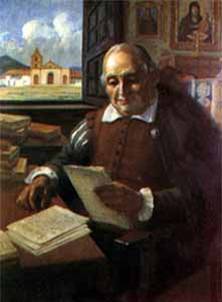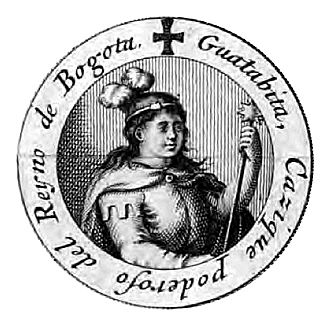Juan Rodríguez Freyle facts for kids
Quick facts for kids
Juan Rodríguez Freyle
|
|
|---|---|

Painting of Juan Rodríguez Freyle
|
|
| Born | April 25, 1566 Bogotá, New Kingdom of Granada |
| Died | 1642 (aged 75–76) Bogotá, New Kingdom of Granada |
| Language | Spanish |
| Nationality | Colombian |
| Subjects | Spanish conquest of the Muisca Spanish conquest of the Chibchan Nations El Dorado |
| Notable work | El Carnero - Conquista y descubrimiento del Nuevo Reino de Granada de las Indias Occidentales del Mar Océano, y Fundación de la ciudad de Santafé de Bogotá, primera de este reino donde se fundó la Real Audiencia y Cancillería, siendo la cabeza se hizo su arzobispado (1638, first published in 1859) |
| Spouse | Francisca Rodríguez |
| Relatives | Juan Freyle (father) Catalina Rodríguez (mother) |
Juan Rodríguez Freyle (sometimes called Juan Rodríguez Freile) was an important writer from the early days of what is now Colombia. He was born in Bogotá, in a place then called the New Kingdom of Granada, on April 25, 1566. He passed away in Bogotá in 1642.
The New Kingdom of Granada was a large Spanish colonial territory. It included parts of modern-day Colombia, Ecuador, Panama, and Venezuela.
Juan Rodríguez Freyle's father was a soldier. Juan knew important people from that time. These included the cacique (leader) of Lake Guatavita and Gonzalo Jiménez de Quesada. Jiménez de Quesada was the person who founded Bogotá.
Juan Rodríguez Freyle's most famous book is called El Carnero. It's a collection of stories, interesting facts, and rumors. These stories are about the early days of the New Kingdom of Granada. They also tell about the end of the Muisca Confederation, a group of indigenous people. El Carnero is a very important book. It helps us understand the 1500s in what is now Colombia. Juan Rodríguez Freyle was married to Francisca Rodríguez.
Contents
About Juan Rodríguez Freyle
Juan Rodríguez Freyle was born in Bogotá. His parents were Juan Freyle and Catalina Rodríguez. His family, the Freyles, came from Alcalá de Henares in Spain. They were a well-respected family.
We don't know much about his early life. He didn't have a full education. He learned to read from Gonzalo García Zorro. García Zorro was the mayor of Bogotá seven times between 1544 and 1564.
His Education and Travels
Rodríguez Freyle studied at the San Luis seminary for two years. But he was asked to leave. This happened because he used a funny nickname for the archbishop Zapata.
Later, Freyle joined trips to fight against indigenous groups. These included the Timaná and Pijao groups. He met Gonzalo Jiménez de Quesada, who founded Bogotá. Jiménez de Quesada died in 1579. Juan also got to know the cacique (leader) of Guatavita.
From 1585 to 1591, Juan spent six years in Spain. He worked as a secretary for a judge called Alonso Pérez Salazar. While in Spain, he saw the city of Cádiz attacked by the famous pirate Francis Drake in 1587. When Pérez Salazar died, Juan had money problems. He was also far from his home country.
Returning Home
Juan Rodríguez Freyle returned to the New Kingdom of Granada. He lived for a while in Cartagena de Indias. After that, he traveled along the Magdalena River. He went back to his hometown of Bogotá. He then focused on farming in Guatavita, Cundinamarca.
Back in Bogotá, he married Francisca Rodríguez in 1603 or 1604. It seems he worked in an office that collected taxes. In his free time, he started to write. People said Rodríguez Freyle was a well-read man. He loved literature.
El Carnero

In the last years of his life, between 1636 and 1638, Rodríguez Freyle wrote his most important book. It was called El Carnero - Conquista y descubrimiento del Nuevo Reino de Granada de las Indias Occidentales del Mar Océano, y Fundación de la ciudad de Santafé de Bogotá, primera de este reino donde se fundó la Real Audiencia y Cancillería, siendo la cabeza se hizo su arzobispado.
This book tells about the first conquistadors (Spanish explorers and conquerors) in Colombia. His own father, Juan Freyle, was a soldier with Pedro de Ursúa. El Carnero is one of the most detailed books about the Spanish conquest of the Muisca.
Rodríguez Freyle wrote this book because he was friends with the cacique of Guatavita. This cacique was one of the main leaders of the Muisca Confederation. Juan Rodríguez Freyle lived in Guasca, Cundinamarca. This was close to the sacred Lake Guatavita. Lake Guatavita is famous for the legend of El Dorado.
El Carnero was first mentioned in history books in 1785. But it wasn't fully published until 1859.
Why El Carnero is Important
El Carnero ("The Sheep") is seen as the most important source for understanding the early colonial period in Colombia. A researcher named Carlos Rey Pereira studied the book for his PhD in 2000. He found that the events described in the book were a mix of common ideas and rumors from that time.
Rodríguez Freyle's book helped fill in gaps in the stories told by two other early Spanish writers: Pedro Simón and Juan de Castellanos. Some people who have reviewed the book point out the writer's viewpoint. He was the child of a conquistador and someone who benefited from the encomienda system (a Spanish labor system).
A scholar named David Bost explained that in those times, history and fiction were often mixed. Writers of history often used storytelling techniques. There wasn't always a clear difference between what was true and what was made up. Historians like Rodríguez Freyle could guess about people and events. Their stories often showed an imaginative way of describing the American scene.
See also
 In Spanish: Juan Rodríguez Freyle para niños
In Spanish: Juan Rodríguez Freyle para niños
- List of Muisca scholars
- Spanish conquest of the Muisca
- Spanish conquest of the Chibchan Nations
- El Carnero
- Gonzalo Jiménez de Quesada

